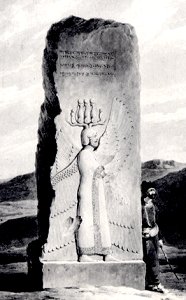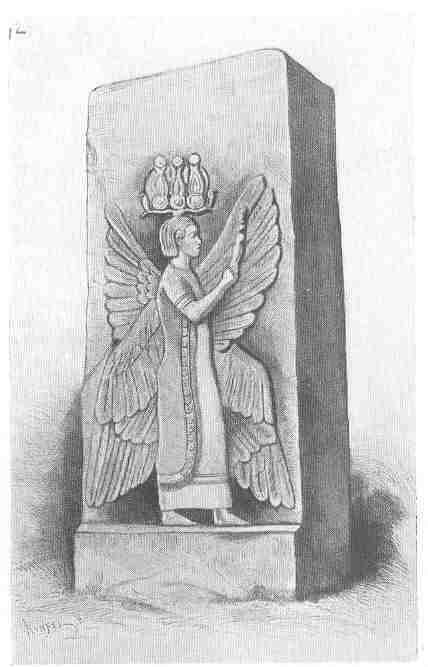Skip to comments.
2500 Year Old Winged Man Of Pasargadae Threatened By Cold And Lichen
Tehran Times ^
| 1-11-2005
Posted on 01/11/2005 5:32:52 PM PST by blam
2500-year-old Winged Man of Pasargadae threatened by cold and lichen
Tehran Times Culture Desk
TEHRAN (MNA) -- The director of the Pasargadae Historical Cultural Complex said here on Sunday that the stone relief of the Winged Man at the ancient site has been seriously damaged by the cold and lichen and other environmental factors.
“Experts began to study the detrimental effects two years ago after some cracks were observed on the relief,” added Babak Kial.
The Winged Man, considered to be Cyrus the Great by some archaeologists and historians, is a relief of a standing man with four wings who is praying. He also wears a crown which has two horns on it. Some scholars say that that Cyrus the Great is Zulqarnain, whose story is told in the Holy Qur’an, because Zulqarnein means “one with two horns” in Arabic.
“Frost, lichen, and the growth of some types of fungus have made some cracks on the relief over the past few years,” said Kial, adding that experts are looking for a way to prevent the destruction of the relief.
“We plan to replace the original relief with a replica and to transfer the original to a museum if experts determine that is necessary,” he stated.
Experts have made several attempts to prevent the extension of cracks on the relief over the years but were unsuccessful.
Pasargadae, the first dynastic capital of the Achaemenid Empire, was founded by Cyrus II, the Great, in Pars, homeland of the Persians, in the 6th century B.C. Its palaces, gardens, and the mausoleum of Cyrus are outstanding examples of the first phase of royal Achaemenid art and architecture and exceptional testimonies of Persian civilization.
UNESCO registered Pasargadae on the World Heritage List on July 1, 2004.
The charter of Cyrus the Great (known as the Cyrus Cylinder), a baked-clay Aryan language cuneiform cylinder, was discovered in 1878 during an excavation of the site of Babylon. In it, Cyrus the Great described his humanitarian treatment of the inhabitants of Babylonia after its conquest by the Iranians.
In related news, some parts of the ancient site of Tang-e Bolaghi, four kilometers from Pasargadae, will be submerged by the Sivand Dam, which is scheduled to become operational in March 2006. Experts say the humidity caused by the dam will also damage other parts of Pasargadae
TOPICS: News/Current Events
KEYWORDS: 2500; archaeology; cold; ggg; godsgravesglyphs; history; lichen; man; old; pasargadae; threatened; winged; year
1
posted on
01/11/2005 5:32:53 PM PST
by
blam
To: SunkenCiv
GGG Ping
Tomb Of Cyrus
Can't find a picture of the Winged Man Of Pasargadae.
2
posted on
01/11/2005 5:37:09 PM PST
by
blam
To: blam
The answer is simple: We must outlaw cold and lichen.
To: blam

Stone relief at Pasargadae, showing a four-winged guardian figure wearing an Egyptian Crown. The inscription, in Old Persian, Elamite and Babylonian, reads, 'I, Cyrus, the king, an Achaemenian.' The upper part of the slab is now missing. Watercolour painted by Sir Robert Ker Porter in 1818.
http://www.art-arena.com/cyrus1.htm
4
posted on
01/11/2005 5:42:20 PM PST
by
Rebelbase
(Who is General Chat?)
To: blam
5
posted on
01/11/2005 5:46:09 PM PST
by
Rebelbase
(Who is General Chat?)
To: blam
Um, global warming, helloooo?
To: Rebelbase
7
posted on
01/11/2005 5:56:04 PM PST
by
blam
To: blam
Ozymandias
By Percy Bysshe Shelley
I met a traveller from an antique land,
Who said--"Two vast and trunkless legs of stone
Stand in the desart....Near them, on the sand,
Half sunk a shattered visage lies, whose frown,
5 And wrinkled lip, and sneer of cold command,
Tell that its sculptor well those passions read
Which yet survive, stamped on these lifeless things,
The hand that mocked them, and the heart that fed;
And on the pedestal, these words appear:
10 My name is Ozymandias, King of Kings,
Look on my Works, ye Mighty, and despair!
Nothing beside remains. Round the decay
Of that colossal Wreck, boundless and bare
The lone and level sands stretch far away."
8
posted on
01/11/2005 5:58:03 PM PST
by
mc6809e
To: RightOnTheLeftCoast
"Um, global warming, helloooo?"
Wait, it's COLD and lichen. And since over last 2500 yrs there have been both warmer and cooler periods, how come that the thing has held for all that time and only started significantly deteriorating 2 years ago? Probably the relief is a recent forgery, which right now is being exposed.
9
posted on
01/11/2005 6:06:01 PM PST
by
GSlob
To: GSlob
That Egyptian crown makes me suspicious. The Persian Empire had nothing to do with Egypt while Cyrus was alive. He thought about conquering Egypt, but his plans were interrupted by a barbarian invasion from Central Asia. He hurried to the other end of his empire to deal with that, and got killed by a Scythian queen named Tomyris, somewhere in Kazakhstan. It was left to his son Cambyses II to conquer Egypt, four years later (525 B.C.).
Remember the time in 2000 when some folks in Pakistan claimed to have the mummy of a Median princess from about 600 B.C., and offered to sell it for $15 million? A few days later it turned out that while the mummy was probably real, her crown and breastplate were modern creations, put on top of the bandages to drive up the price.
If anything, Cyrus ought to be wearing either a Persian or a Babylonian-style crown.
10
posted on
01/11/2005 6:16:27 PM PST
by
Berosus
To: Berosus
Well, that fruit basket depicted in the pictures on this thread does not look like a traditional Egyptian crown to me. As I remember it, it used to be depicted as a rather tall and narrow contraption.
11
posted on
01/11/2005 6:21:04 PM PST
by
GSlob
To: blam
seriously damaged by the cold and lichen and other environmental factors It is colder now than it has been in the last 2,500 years?
Interesting.
To: blam
13
posted on
01/11/2005 6:27:04 PM PST
by
Fiddlstix
(This Tagline for sale. (Presented by TagLines R US))
To: mc6809e
The name "Ozymandias" is from the Greek rendering of the name Usermaetre, one of the names of the Egyptian pharaoh Ramesses II.
To: blam
You mean the MUllahs have not blown it up yet? It violates Islam!
15
posted on
01/11/2005 7:43:34 PM PST
by
Ruy Dias de Bivar
(Pity the poor athiest. He has no one to put the blame on.)
To: blam; FairOpinion; Ernest_at_the_Beach; SunkenCiv; 24Karet; 3AngelaD; 4ConservativeJustices; ...
Thanks Blam. Please FREEPMAIL me if you want on, off, or alter the "Gods, Graves, Glyphs" PING list --
Archaeology/Anthropology/Ancient Cultures/Artifacts/Antiquities, etc.
The GGG Digest -- Gods, Graves, Glyphs (alpha order)
16
posted on
01/11/2005 11:03:52 PM PST
by
SunkenCiv
(the US population in the year 2100 will exceed a billion, perhaps even three billion.)
To: blam
17
posted on
01/11/2005 11:10:35 PM PST
by
SunkenCiv
(the US population in the year 2100 will exceed a billion, perhaps even three billion.)
To: blam
Threatened By Cold And Lichen? Just wait until radical Islam gets a hold of it. It'll go to dust like those huge ancient Buddhist statues.
Allahu-ak-barbarian!
18
posted on
01/11/2005 11:13:36 PM PST
by
broadsword
( It's Islam against America, and, by God, WE WILL TRIUMPH, traitors and appeasers be damned!)
To: GSlob
You're right. Most of the time the pharaoh wouldn't wear a crown like that. But they had several crowns, and most were only worn on special occasions. The blue one that appears in some pictures, for instance, was apparently only worn when he was going into battle. The one feature common to all of them was that they had an image of the cobra in the front.
I remember seeing a relief sculpture in a museum that showed Thutmose I wearing this one. Unfortunately I don't remember what he was doing at the time.
19
posted on
01/12/2005 8:16:57 PM PST
by
Berosus
To: blam
Alexander the Great probably stopped and marveled at this statue on his way thru Asia.
20
posted on
01/12/2005 8:24:01 PM PST
by
Ciexyz
(I use the term Blue Cities, not Blue States. PA is red except for Philly, Pgh & Erie)
Disclaimer:
Opinions posted on Free Republic are those of the individual
posters and do not necessarily represent the opinion of Free Republic or its
management. All materials posted herein are protected by copyright law and the
exemption for fair use of copyrighted works.
FreeRepublic.com is powered by software copyright 2000-2008 John Robinson

